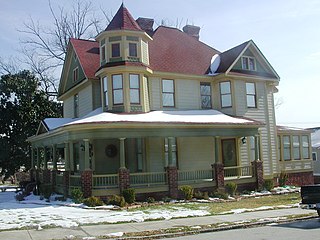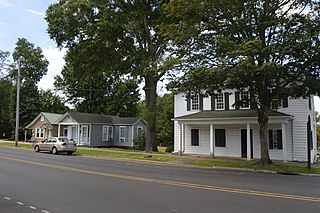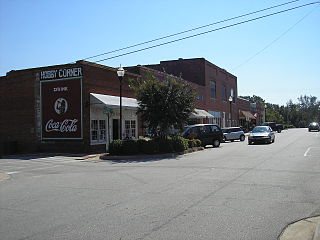
Lincolnton is a city in Lincoln County, North Carolina, United States, within the Charlotte metropolitan area. The population was 10,486 at the 2010 census. Lincolnton is northwest of Charlotte, on the South Fork of the Catawba River. The city is the county seat of Lincoln County, and is the only legally incorporated municipality wholly within the rural county.

Alston-DeGraffenried Plantation or Alston-DeGraffenried House is a historic property located in Chatham County, North Carolina, near Pittsboro, North Carolina. It includes a plantation house built through the forced labor of at least 11 enslaved people between about 1810 and 1825, and its surrounding agricultural fields. The property was first listed on the National Register of Historic Places in 1974 and the listed area was increased in 1993. The house and the surrounding land are identified as a national historic district.

The Shepard Street–South Road Street Historic District is a national historic district located at Elizabeth City, Pasquotank County, North Carolina. The district encompasses 161 contributing buildings in a historically African-American section of Elizabeth City. The district developed from the mid-19th to mid-20th century, and includes representative examples of Greek Revival, Gothic Revival, Italianate, Queen Anne, Colonial Revival, Bungalow, and American Foursquare style architecture. Notable contributing buildings include the Sawyer–Pailin–Overman House, Antioch Presbyterian Church, (former) St. Catherine Catholic Church (1941), Olive Branch Missionary Baptist Church (1904), Corner Stone Missionary Baptist Church (1888), (former) St. Phillips Episcopal Church (1893), the Sundry Shop, Rex Cleaning Works (1932), Good Samaritan Hall (1896), and Republican Star Odd Fellows Hall.

Emmanuel Lutheran Church is a historic Lutheran church building located at 216 S. Aspen Street in Lincolnton, Lincoln County, North Carolina. It was built in 1919, and is a rectangular Late Gothic Revival style brick church with a four-stage central tower with a conical steeple. It features pale beige terra cotta, cast stone, granite, and poured cement detailing; lancet arched door and window openings; and stepped buttresses.

First Baptist Church, also known as the Lincoln Cultural Center, is a historic Baptist church located at 403 E. Main Street in Lincolnton, Lincoln County, North Carolina. The building was designed by architect James M. McMichael in a Classical Revival style with a tetrastyle two-story portico and a spherical dome. Its plans were approved in 1919; construction was completed in 1922. The building was acquired by Lincoln County and renovated as the Lincoln Cultural Center and opened for public use in September 1991.

First United Methodist Church is a historic United Methodist church building located at 201 E. Main Street in Lincolnton, Lincoln County, North Carolina. It was built in three stages in 1919–1920, 1936, and 1956–1957. The oldest section is a two-story Classical Revival style brick church with a two-story portico and dome-covered sanctuary.

St. Luke's Episcopal Church and Cemetery is a historic Episcopal church complex, cemetery, and national historic district located at 303-321 N. Cedar Street, 322 E. McBee Street in Lincolnton, Lincoln County, North Carolina. The complex includes the church, parish hall, and rectory. The church was built in 1885–1886, and is a Late Gothic Revival style frame structure with a brick veneer added in 1922–1923. The tower is believed to date to 1859. The parish hall was built in 1907, and is a one-story, rectangular frame building. The rectory was built in 1911–1912, and is a two-story, "T"-form Colonial Revival style dwelling with a pebbledash finish. The cemetery includes approximately 300 gravestones, with the earliest dating to 1854.

Southport Historic District is a national historic district located at Southport, Brunswick County, North Carolina. The district encompasses 161 contributing buildings, 3 contributing sites, and 1 contributing object. Over half of the structures in the historic district date from the 1885-1905 period. It includes residential, commercial, and institutional buildings and is considered the best example of a Victorian coastal town in North Carolina. Notable buildings include the River Pilots Tower and Building (1940s), Frying Pan Lightship, Fort Johnston Officers Quarters, Walker-Pike House, Brunswick Inn, Fort Johnston Hospital, Former Brunswick County Court House, Saint Philips Episcopal Church, Trinity Methodist Church (1888-1890), and the Adkins-Ruark House (1890).

South Main Street Historic District is a national historic district located at Kernersville, Forsyth County, North Carolina. The district encompasses 53 contributing buildings, 2 contributing sites, and 2 contributing objects in Kernersville. They include residential and commercial buildings built between about 1834 and 1930 in a variety of popular architectural styles including Colonial Revival, Queen Anne, and Bungalow / American Craftsman style. Located in the district is the separately listed Korner's Folly. Other notable buildings include Spears House, Dr. Elias Kerner House (1857), Elias Kerner Huff House (1880), Greenfield and Kerner Tobacco Factory (1884), (former) Bank of Kernersville (1903), DeWitt Harmon's Office, Kernersville Moravian Church (1922), and Main Street United Methodist Church (1924/25).

South Greensboro Historic District, also known as the Asheboro Street Historic District, is a national historic district located in the Southside neighborhood, Greensboro, Guilford County, North Carolina. The district encompasses 327 contributing buildings, 1 contributing site, 10 contributing structures, and 1 contributing object in a predominantly residential section of Greensboro. The houses were largely built between the 1870s and the 1930s and include notable examples of Queen Anne, Italianate, American Foursquare, and Bungalow / American Craftsman-style architecture. Notable buildings include the Atkinson House, Hanner House, B.E. Jones House, T. Bernard House, C.O. Younts House, W.S. Witherspoon House, and R. N. Watson House, former Asheboro Street Church, and Nettie Mae Coad Apartments.

Loretz House is a historic home located near Lincolnton, Lincoln County, North Carolina. It was built in 1793, and is a two-story, five bay by two bay, brick dwelling. It has a gable roof and features patterned brickwork. The interior has a number of Georgian style decorative elements. Also on the property is a contributing brick smokehouse.

Lincoln County Courthouse is a historic courthouse building located at Lincolnton, Lincoln County, North Carolina. It was designed by Raleigh architect James A. Salter and built in 1921. It is three-story, ashlar stone, Classical Revival style building. It has a taller central section flanked by flat roofed wings, matching pedimented hexastyle Doric order porticoes on the front and rear of the center section, and a Doric frieze along its sides.

Pleasant Retreat Academy, also known as The Confederate Memorial Hall, is a historic building located at 129 East Pine Street, Lincolnton, North Carolina.

Methodist Church Cemetery is a historic Methodist cemetery and national historic district located at Lincolnton, Lincoln County, North Carolina. It was established about 1828, and contains the marked graves of some 275 members of the Methodist church, and/or citizens of Lincolnton. The gravestones include notable examples of 19th and early-20th century funerary art. The property was also the site of Lincolnton's Methodist churches and religious worship from about 1822 until 1920.

Old White Church Cemetery, also known as Emanuel Church Cemetery, is a historic cemetery and national historic district located at Lincolnton, Lincoln County, North Carolina. It was established in 1788, and contains the marked graves of some 265 citizens of Lincolnton, with an even larger number of unmarked graves. The oldest marked grave dates to 1801. The gravestones include notable examples of 19th and early-20th century funerary art. It is the oldest burying ground in the town of Lincolnton.

Lincolnton Commercial Historic District is a national historic district located at Lincolnton, Lincoln County, North Carolina. It encompasses 62 contributing buildings and 2 contributing objects in the central business district of Lincolnton. It includes a variety of commercial, institutional, and industrial buildings dating between about 1900 and 1955. Located in the district are the separately listed Classical Revival style Lincoln County Courthouse and First United Methodist Church. Other notable buildings include the Frank Beal House, Karl L. Lawing House, Reinhardt Building, Carolina First National Bank, Central Candy and Cigar Company, Jonas Building, Wampum Department Stores, Rhodes and Corriher Company building, and Coca-Cola Bottling Company building.

West Main Street Historic District is a national historic district located at Lincolnton, Lincoln County, North Carolina. It encompasses 18 contributing buildings in a predominantly residential section of Lincolnton. It includes notable examples of Federal, Greek Revival and Colonial Revival style architecture dating between about 1819 and 1941. Located in the district is the separately listed Shadow Lawn. Other notable buildings include the Michal-Butt-Brown-Pressly House, William H. Michal House, Rouser-Hildebrand-Burgin House, Robert Steve Reinhardt House, and Charles Hoover, Jr., House.

Elizabeth City Historic District is a national historic district located at Elizabeth City, Pasquotank County, North Carolina. The district encompasses 592 contributing buildings, 1 contributing site, 1 contributing structure, and 1 contributing object in the central business district and surrounds residential sections of Elizabeth City. The district developed after 1789, and includes representative examples of Greek Revival, Federal, and Late Victorian style architecture. Notable contributing buildings include the Grice-Fearing House (1789-1808), Shirley Armstrong House, Goodman-Matthews-Pool House, Dr. William Martin House, Pool-Kennedy-Lumsden House, Charles-Hussey House, Richardson-Pool House, North Carolina Building (1859), Cobb Building, the former First Methodist Church, Christ Episcopal Church (1857), J. W. Dent House, Dr. Butt's Drug Store, the McMullen Building, the Lowrey Building, former Citizens Bank, Robinson Building (1903), Kramer Building (1909), Selig Building (1925), the Virginia Dare Hotel and Arcade (1927), First Baptist Church (1889), United States Post Office and Courthouse, and Pasquotank County Courthouse (1882).

Academy Street Historic District is a national historic district located at Madison, Rockingham County, North Carolina. It encompasses 12 contributing buildings in the town of Madison. It was developed from the mid-19th to mid-20th century, and includes notable examples of a variety of popular architectural styles. Notable buildings include the Twitchell-Gallaway House (1824), Foy-McAnally House, Cardwell-Black House, Churchill House, Martin House, Madison United Methodist Church, Pratt-Van Noppen House, and Wakeham (1921).

The Lincolnton Historic District, in Lincolnton, Georgia, is a historic district which was listed on the National Register of Historic Places in 1993. It included 126 contributing buildings, a contributing structure, a contributing site, and a contributing object.






















